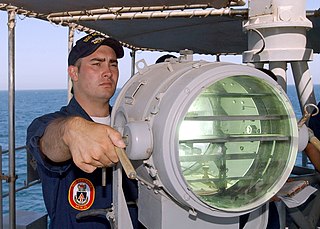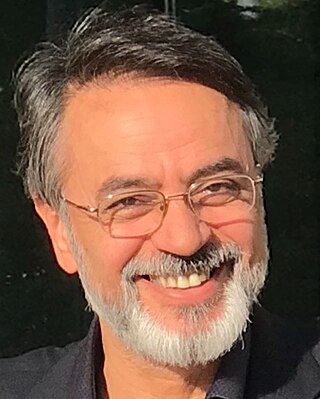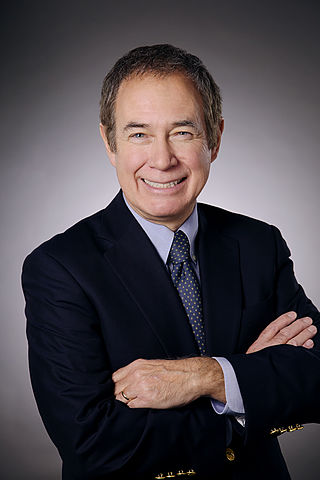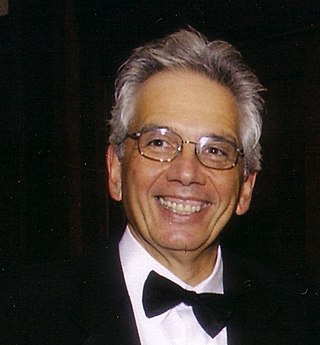Related Research Articles

Sir Charles Kao Kuen was a Chinese physicist and Nobel laureate who contributed to the development and use of fiber optics in telecommunications. In the 1960s, Kao created various methods to combine glass fibers with lasers in order to transmit digital data, which laid the groundwork for the evolution of the Internet.

Free-space optical communication (FSO) is an optical communication technology that uses light propagating in free space to wirelessly transmit data for telecommunications or computer networking. "Free space" means air, outer space, vacuum, or something similar. This contrasts with using solids such as optical fiber cable.

Optical communication, also known as optical telecommunication, is communication at a distance using light to carry information. It can be performed visually or by using electronic devices. The earliest basic forms of optical communication date back several millennia, while the earliest electrical device created to do so was the photophone, invented in 1880.

Photonics is a branch of optics that involves the application of generation, detection, and manipulation of light in form of photons through emission, transmission, modulation, signal processing, switching, amplification, and sensing. Photonics is closely related to quantum electronics, where quantum electronics deals with the theoretical part of it while photonics deal with its engineering applications. Though covering all light's technical applications over the whole spectrum, most photonic applications are in the range of visible and near-infrared light. The term photonics developed as an outgrowth of the first practical semiconductor light emitters invented in the early 1960s and optical fibers developed in the 1970s.
Jean-Claude Simon is a researcher in the field of semiconductor optical amplifiers. Since 1998 he was permanent professor at ENSSAT / University of Rennes1. Director of FOTON, research department in Optics and Optoelectronics for Telecom, affiliated to CNRS.

Fiber-optic communication is a method of transmitting information from one place to another by sending pulses of infrared or visible light through an optical fiber. The light is a form of carrier wave that is modulated to carry information. Fiber is preferred over electrical cabling when high bandwidth, long distance, or immunity to electromagnetic interference is required. This type of communication can transmit voice, video, and telemetry through local area networks or across long distances.

Jawad A. Salehi, IEEE Fellow & Optica Fellow, born in Kazemain (Kadhimiya), Iraq, on December 22, 1956, is an Iranian electrical and computer engineer, pioneer of optical code division multiple access (CDMA) and a highly cited researcher. He is also a board member of Academy of Sciences of Iran and a fellow of Islamic World Academy of Sciences. He was also elected as a member of Iranian Science and Culture Hall of Fame in Electrical Engineering, October 2010.

Tingye Li was a Chinese-American scientist in the fields of microwaves, lasers and optical communications. His innovative work at AT&T pioneered the research and application of lightwave communication, and has had a far-reaching impact on information technology for over four decades.

Telecommunications engineering is a subfield of electronics engineering which seeks to design and devise systems of communication at a distance. The work ranges from basic circuit design to strategic mass developments. A telecommunication engineer is responsible for designing and overseeing the installation of telecommunications equipment and facilities, such as complex electronic switching systems, and other plain old telephone service facilities, optical fiber cabling, IP networks, and microwave transmission systems. Telecommunications engineering also overlaps with broadcast engineering.
Stewart E. Miller was a noted American pioneer in microwave and optical communications.
Robert D. Maurer is an American industrial physicist noted for his leadership in the invention of optical fiber.
John O. Limb is an Australian engineer, known for fundamental contributions to the development of digital video communications and holder of a series of patents related to computer communications.
Rod C. Alferness was president of The Optical Society in 2008.

John Mathew Cioffi is an American electrical engineer, educator and inventor who has made contributions in telecommunication system theory, specifically in coding theory and information theory. Best known as "the father of DSL," Cioffi's pioneering research was instrumental in making digital subscriber line (DSL) technology practical and has led to over 400 publications and more than 100 pending or issued patents, many of which are licensed.

Kenneth O. Hill is a Mexican Canadian physicist who specializes in the field of photonics. In the late 1970s, he discovered the phenomena of photosensitivity in optical fiber and has worked extensively in its applications. He first demonstrated Fiber Bragg gratings and their applications in optical communication and optical sensor systems. Further areas of his discovery and innovation include the phase mask technique for grating fabrication, fiber grating dispersion compensators, and wavelength selective fiber filters, multiplexers and demultiplexers. This field of research has led to the ability to create high speed fiber optic networks as well as many other communication applications that have revolutionized the telecommunications industry.

Paul R. Prucnal is an American electrical engineer. He is a professor of electrical engineering at Princeton University. He is best known for his seminal work in Neuromorphic Photonics, optical code division multiple access (OCDMA) and the invention of the terahertz optical asymmetric demultiplexor (TOAD). He is currently a fellow of IEEE for contributions to photonic switching and fiber-optic networks, Optical Society of America and National Academy of Inventors.
David F. Welch is an American businessman and research scientist. Welch is a pioneer in the field of optical devices and optical transport systems for telecommunications networks. Welch first made it possible to commercially deploy reliable 980 nm laser pumps, needed in low noise optical amplifiers employed in dense wavelength division multiplexing (DWDM) telecommunications systems. He also achieved the first commercial optoelectronics integrated circuit, several years ahead of any competing research or developments laboratory.

Richard D. Gitlin is an electrical engineer, inventor, research executive, and academic whose principal places of employment were Bell Labs and the University of South Florida (USF). He is known for his work on digital subscriber line (DSL), multi-code CDMA, and smart MIMO antenna technology all while at Bell Labs.
Govind P. Agrawal is an Indian American physicist and a fellow of Optica, Life Fellow of the IEEE, and Distinguished Fellow of the Optical Society of India. He is the recipient of James C. Wyant Professorship of Optics at the Institute of Optics and a professor of physics at the University of Rochester. He is also a Distinguished scientist at the Laboratory for Laser Energetics (LLE) in the University of Rochester. Agrawal has authored and co-authored several highly cited books in the fields of non-linear fiber optics, optical communications, and semiconductor lasers.
Satya Prasad Majumder is a Bangladeshi academic. He is the current and the 14th vice-chancellor of Bangladesh University of Engineering and Technology.
References
- 1 2 Stewart D. Personick (1970). Efficient analog communication over quantum channels (Thesis). Massachusetts Institute of Technology. Department of Electrical Engineering Thesis. hdl:1721.1/13798.
- ↑ "Are We Jeopardizing Our Most Important Long-Term Asset: Trust?". Debate biographies. IEEE Communication Society. March 25, 2009. Retrieved June 8, 2013.
- ↑ Jerry D. Gibson, ed. (8 October 2018). The Communications Handbook. pp. 48–6. ISBN 9781420041163.
- ↑ R. G. Smith & H. W. Reinbold (July–August 1978). "Atlanta Fiber Systems Experiment: Optical Detector Package" (PDF). Bell System Technical Journal . 57 (6): 1809–1822. doi:10.1002/j.1538-7305.1978.tb02128.x. S2CID 8465489 . Retrieved June 8, 2013.
- ↑ S. D. Personick (March 1977). "Photon Probe—An Optical-Fiber Time-Domain Reflectometer" (PDF). Bell System Technical Journal . 56 (3): 355–366. doi:10.1002/j.1538-7305.1977.tb00513.x. S2CID 44491460 . Retrieved June 8, 2013.
- 1 2 "Personick, Stewart D." Faculty page. New jersey Institute of Technology. Archived from the original on August 4, 2011. Retrieved June 8, 2013.
- ↑ Duwayne R. Anderson; Larry M. Johnson; Florian G. Bell (2004). Troubleshooting Optical Fiber Networks: Understanding and Using Optical Time-Domain Reflectometers. Academic Press. p. 4. ISBN 0080492363.
- ↑ "Federal Networking Council Advisory Committee Members". Official web site. December 20, 1996. Archived from the original on October 22, 1997. Retrieved June 8, 2013.
- ↑ "Is There a Role for the US Government in Technology Development?". IEEE Archives. June 10, 1996. Retrieved June 8, 2013.[ permanent dead link ]
- ↑ James Gleick (May 16, 1993). "The Telephone Transformed — Into Almost Everything". The New York Times. p. 26. Retrieved June 8, 2013.
- 1 2 3 "Stewart D. Personick 2000 John Tyndall Award Winner". April 2000. Archived from the original on 2016-03-04. Retrieved June 8, 2013.
- ↑ Stewart D. Personick (December 4, 2000). "Computing the Shannon Information Capacity of an Optical Fiber" (PDF). Retrieved June 9, 2013.
- ↑ Stewart D. Personick, Drexel University (November 6, 2001). "Photonic Switching" (PDF). Institute of Electrical and Electronics Engineers (IEEE). Archived from the original (PDF) on June 15, 2004. Retrieved June 9, 2013.
- ↑ "Stewart D. Personick". Business Week. Archived from the original on June 20, 2013. Retrieved June 8, 2013.
- ↑ "Telecommunications and Networking Giant Joins NJIT as Wireless Telecom Chair". June 19, 2008. Archived from the original on 2012-03-19. Retrieved June 8, 2013.
- ↑ "IEEE Fellows 1983 | IEEE Communications Society".
- ↑ Critical Autonomous Vehicles in Support of Naval Operations. National Academies Press. 2005. ISBN 9780309181235.
- ↑ Stewart D. Personick; Cynthia A. Patterson, eds. (2003). Critical Information Infrastructure Protection and the Law: An Overview of Key Issues. National Academies Press. ISBN 9780309088787.